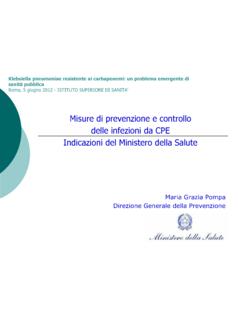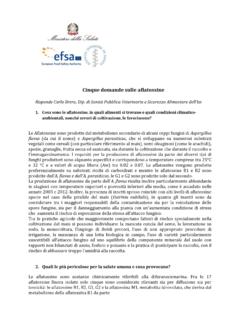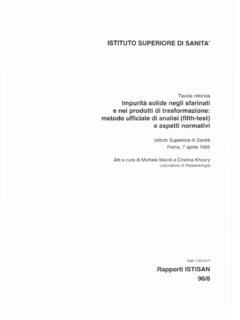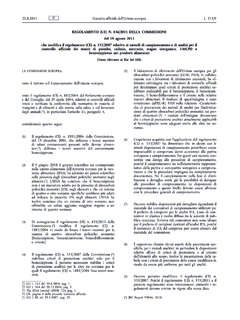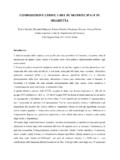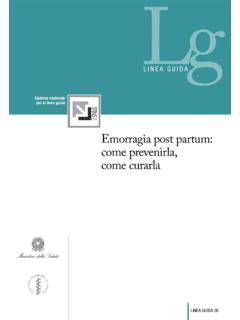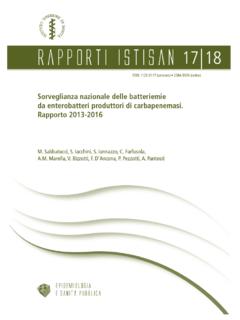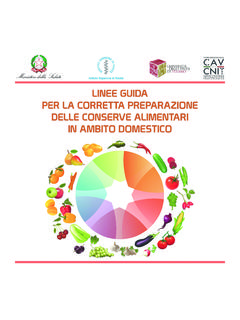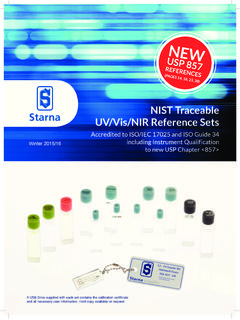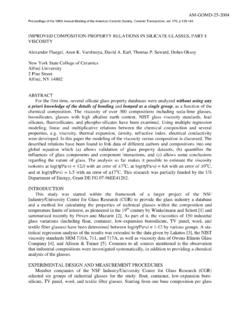Transcription of Frequently asked questions on calibration
1 FAQ on calibration Rationale From experiences gained in inter-laboratory comparison studies, being it proficiency tests or method validation studies by collaborative trial, we know that the importance of instrument calibration and its effect on analysis results is Frequently underestimated. Participants to some of the studies expressed their wish to get more guidance on instrument calibration ; despite a number of international guidance documents is already available. This situation could be explained by the difficult language applied in some of the guides, respectively the lack of knowledge on where to find very practical and easily understandable guidance. The more than five million hits gained at the time of writing this text with one of the most prominent internet search engines for the term "instrument calibration " do not really contribute to improve the situation.
2 Therefore we felt it necessary to prepare this document that aims to address some aspects of standard preparation and instrument calibration for the determination of polycyclic aromatic hydrocarbons (PAHs), respectively mycotoxins in food that seem to provide difficulties to some operators. Like in every question-and-answer scenario one will face the fact that either a question can be asked extremely specific, resulting in a similar specific answer or a question can be asked rather general and the answer thus might also be rather general. This might result in a dilemma, in which the answer to a question might not be the one of interest, because either it is too specific and not applicable to the exactly (slightly different) question one might have, or it is too general and does not touch specific aspect one had in mind.
3 In other words: If a model is simple, it likely will be wrong, if it is complex, it surely is impractical . Applying this to this guide, the compromise was to try to answer both to relevant general issues but also to a few specific ones that are sometimes encountered. The format of the guide was chosen on purpose, because as a Frequently asked questions (FAQ) document it remains open to address and include any question regarding standard preparation and instrument calibration that might come up in future. 1. FAQ on calibration Index Standard preparation .. 3. 1. Where do I get reference materials for PAH analysis from? .. 3. 2. Which level of purity of reference materials is acceptable? .. 4. 3. Which are the advantages of gravimetric standard preparation? .. 4. 4. Which type of balance do I need for the preparation of calibration standards ?
4 4. 5. Is serial dilution of a standard solution for the preparation of calibration standards acceptable? .. 5. 6. How shall I store PAH standard solutions?.. 6. 7. Which containers shall I use for storage of standard solutions? .. 7. 8. How shall I estimate the shelf life of my standard preparations? .. 7. 9. Which type of volumetric glassware may I use for the preparation of calibration standards ? .. 8. 10. How do I verify the concentration of my standard preparations? .. 8. 11. How many points do I need for a calibration curve? .. 9. 12. How many replicates per calibration point?.. 11. 13. Why shall the concentration levels of the calibration standards be equidistant? .. 12. 14. Which range of concentration has the calibration to cover? .. 14. 15. Which type of internal standard shall I use?
5 15. 16. When do I need to prepare matrix matched calibration standards ? .. 16. 17. How do I determine matrix effects? .. 17. 18. In which sequence shall I measure the calibration standards ? .. 18. Evaluation of calibration measurements .. 18. 19. How shall I test for linearity of the calibration ?.. 18. 20. Does a correlation coefficient (r) of indicate linearity of calibration ? .. 19. 21. Which level of R is sufficient?.. 19. 22. Which information can I get from the plot of residuals? .. 20. 23. What is the residual standard deviation?.. 20. 24. May I force the calibration curve through the origin?.. 20. 25. What is homo- and heteroscedasticity? .. 20. 26. How do I test for homoscedasticity / heteroscedasticity? .. 21. 27. Linear regression or weighted linear regression which shall I apply?
6 21. 28. May I remove outliers? .. 21. 29. How do I estimate confidence and prediction intervals? .. 22. General .. 23. 30. Is there any internationally harmonised document on calibration ?.. 23. 31. Where can I get guidance on calibration ? .. 23. 2. FAQ on calibration Standard preparation 1. Where do I get reference materials for PAH analysis from? A number of suppliers of chemicals have PAH standards in their assortment. A non-exhaustive list of suppliers, respectively links to other sources of information is given in the following: The International Society for Polycyclic Compounds (ISPAC) has on its website a list of suppliers of polycyclic aromatic hydrocarbons and heterocyclic aromatic compounds both neat and in solution: ISPAC standards A searchable database on suppliers of different chemicals is on the homepage of Chemindustry ( ).
7 The following link gives an example for suppliers of benzo[a]pyrene (neat, and in solution): ChemIndustry: example of search for benzo[a]pyrene A similar searchable database which returns besides the name of different suppliers also some information on the product ( packaging size) can be found on the webpage A large collection of PAH reference substances, among others different certified reference materials, is included in the 2008/2009 catalogue of LGC. It contains single substance reference materials (neat and in solutions, native and labelled) as well as PAH mixtures. LGC standards - Important suppliers of reference materials for PAH in Europe (non-exhaustive list). ALFA Aesar, Chiron, Dr. Ehrenstorfer, SIGMA Aldrich, VWR. - certified reference materials (CRMs) for PAHs The Institute for reference Materials and Measurements (IRMM), LGC, the National Institute of standards and Technology (NIST).
8 3. FAQ on calibration 2. Which level of purity of reference materials is acceptable? A purity of 100 % would be desirable, but in reality most of the target PAHs (15+1 EU priority PAHs). are available on the market in purities of above 95%. Hence the operator has to choose a reference material with a purity that is suitable for the particular task. However, care must be given that impurities do not interfere with the target analytes. The purity of the reference substances shall be considered in the calculation of the standard concentrations. The uncertainty of the purity shall be included in the measurement uncertainty estimate. 3. Which are the advantages of gravimetric standard preparation? The weighing procedure is more precise than handling of volumes, which results normally in smaller uncertainties.
9 Handling of low volumes of liquids is difficult due to the influence of many factors such as surface tension, and leads Frequently to bias. For gravimetric standard preparation it shall be noted that the uncertainty from weighing increases with decreasing amounts of weighed substance. This has consequences for the selection of the type of balance and the weighing procedure applied. A prerequisite for gravimetric standard preparation is thermal equilibrium of the balance and all chemicals and consumables which are used for the standard preparation. Thermal equilibration might take a couple of hours especially in case of large solvent volumes. Before starting with gravimetric standard preparation make sure that the balance is working properly, by applying suitable check weights.
10 4. Which type of balance do I need for the preparation of calibration standards ? An analytical balance with a readability of mg, respectively mg for weighing of substances at levels as low as about 30 milligram, will be fit for the purpose, which means that the uncertainty of weighing is at an acceptable level. The US Pharmacopeia [1] defines the minimum permissible weight of a balance as a load that will give a relative uncertainty of less than As a rule of thumb the minimum weight can be estimated for a balance by multiplying the readability of the balance ( mg) with a factor between 3000. and 5000. 4. FAQ on calibration However the applicability of this rule of thumb depends on the precision of the balance and has to be evaluated experimentally according to Eq 1: 3 x Stdev of 10 measurements Eq 1.

